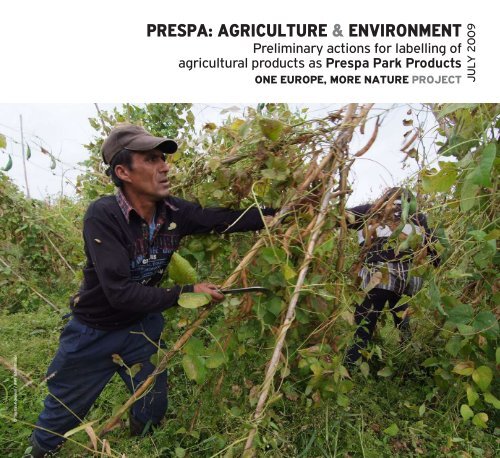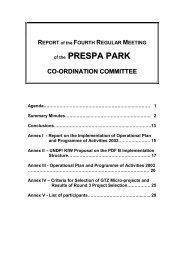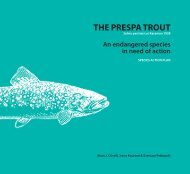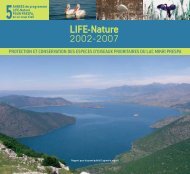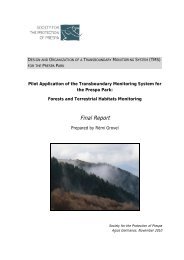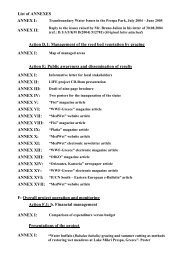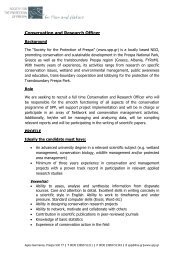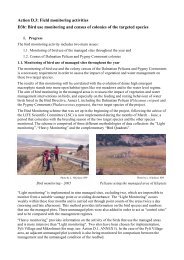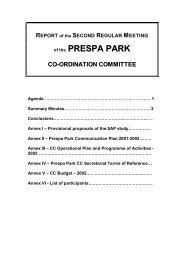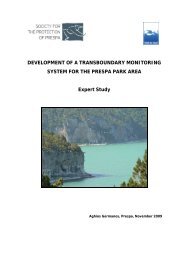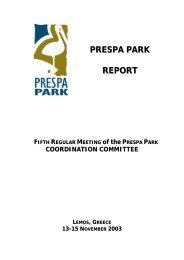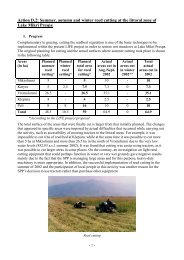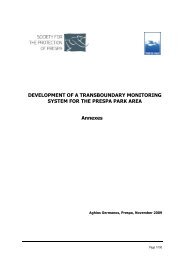PRESPA: AGRICULTURE & ENVIROMENT
PRESPA: AGRICULTURE & ENVIROMENT
PRESPA: AGRICULTURE & ENVIROMENT
Create successful ePaper yourself
Turn your PDF publications into a flip-book with our unique Google optimized e-Paper software.
© Toomas Kokovkin / WWF International<br />
<strong>PRESPA</strong>: <strong>AGRICULTURE</strong> & ENVIRONMENT<br />
Preliminary actions for labelling of<br />
agricultural products as Prespa Park Products<br />
ONE EUROPE, MORE NATURE PROJECT<br />
JULY 2009
The “One Europe, More Nature” project<br />
www.panda.org/europe/oemn<br />
Both in Greece and the rest of Europe, the countryside and the natural environment<br />
face an increasing pressure due to the intensification of agriculture, the irrational<br />
use of agrochemicals, the depletion of natural resources and other factors. At<br />
the same time, an important part of the total population works and lives in these<br />
areas, while agriculture is significantly influenced by the new market trends and<br />
the European Union policies.<br />
The “One Europe, More Nature” project focussed on areas of high natural value<br />
aiming at combining nature protection and the sustainable use of natural resources<br />
with local development and improvement of the inhabitants’ standard of living.<br />
The basic principle of the project was that nature and business can co-exist and<br />
lead to a new win-win situation. The farmers can overcome modern restrictions<br />
through new products and services. The productive activity -that is being practiced<br />
with respect to the environment- can increase the competitiveness of the local<br />
economy, creating opportunities for new income sources.<br />
The OEMN was funded by WWF Netherlands through the “Global Freshwater<br />
Programme” of WWF International. In the Prespa Park area it was implemented<br />
by the Society for the protection of Prespa (SPP) from 2005 to June 2009 with<br />
the cooperation of the Prespa National Forest Management Body (PNFMB) and<br />
WWF Greece. At the same time, the project was also running in:<br />
• Coto Doñana, Spain<br />
• Maramures, Romania<br />
• Tisza Floodplain, Hungary<br />
• Ardennes, Belgium<br />
• Gelderse Poort, the Netherlands<br />
• Sinca Noua, Romania<br />
• Väinameri, Estonia<br />
• Merja Zerga, Morocco<br />
SPP staff in the OEMN project were the following:<br />
• Yiannis Chardaloupas, agronomist, project coordinator<br />
• Marios Savvidis, field agronomist<br />
• Stylianos Karfopoulos, field agronomist<br />
• Anny Anastasiadou, field agronomist<br />
• Irene Koutseri, biologist<br />
• Yiannis Kazoglou, agronomist-environmentalist<br />
• Yiorgos Michalopoulos, agronomist<br />
Implementation of the OEMN project in Prespa would not be feasible without the<br />
voluntary participation and contribution of many residents of the area to whom<br />
special thanks are expressed. The farmers and farm managers who participated<br />
in the 2007 and 2008 pilot projects were:<br />
Tasos Anastasiadis, Thomai Anastasiadou, Yiorgos Diakopoulos, Sofia Kakarantza,<br />
Tasos Michailidis, Anastasia and Michalis Boutlas, Maria Nalpantidou, Tasos,<br />
Yiannis and Stergios Nonas, Nikos and Vasso Papadopoulou, Pantelis and Popi<br />
Samsonidou, Theodoros Sidiropoulos, Georgia Tila, Xristos, Apostolos and<br />
Leonidas Tsikos, and Thomai Tsikou.<br />
Precious was also the collaboration of Eleni Vrantsi, agronomist of the PNFMB,<br />
and Dimitris Kostitsis, agronomist of the Union of Agricultural Cooperatives of<br />
Florina, member of the PNFMB’s Board and responsible for overseeing the project<br />
on behalf of the PNFMB.<br />
SOCIETY<br />
FOR THE PROTECTION<br />
OF <strong>PRESPA</strong> (SPP)<br />
The Society for the Protection of Prespa,<br />
a non- profit environmental organization,<br />
was founded in 1991 and it was the<br />
first coordinated effort of environmental<br />
organizations for the protection of the<br />
area. The official initiative was taken by the<br />
«Friends of Prespa» and WWF International<br />
and hence SPP was established with<br />
the participation of 10 environmental<br />
organizations from Greece, France, Denmark<br />
and the United Kingdom. The actions of the<br />
Society for the Protection of Prespa aim to<br />
wise management, sustainable development,<br />
protection of wildlife and public awareness.<br />
The organic cultivation of beans in Prespa<br />
has been initiated by the Society since 1992,<br />
through advice onfarming and certification<br />
issues. Within the frame of the “One Europe,<br />
More Nature” project, SPP initiated an effort<br />
for the establishment of a “Prespa Park<br />
Product” labelling scheme.<br />
3
Prespa Park a transboundary area<br />
with unique natural and cultural value<br />
The transboundary Prespa Park comprises the Lakes Mikri and Megali Prespa<br />
and the land surfaces extending from the littoral zone to the mountain ridges that<br />
delineate the hydrological basin of Prespa. This is the first transboundary protected<br />
area in the Balkans, established by a Joint Declaration of the Prime Ministers of<br />
the three neighbouring states (Greece, Albania and the former Yugoslav Republic<br />
of Macedonia) in February 2000.<br />
The area holds two of the oldest lakes in Europe and a wealth of biodiversity-rich<br />
ecosystems that intermingle in a unique way from the altitude of 850 metres up<br />
to 2400 metres above sea level and host populations of endangered and endemic<br />
species, such as the Dalmatian pelican, the pygmy cormorant, the brown bear, the<br />
wolf, the barbel, the bleak and the trout of Prespa.<br />
The first impression of the Prespa Park that one takes in is indisputably defined<br />
by its stunning landscape. Inside the Park, the Lakes with their islands, the littoral<br />
wetlands, the riverine forests, the shrub formations that gradually lead up to the<br />
oak, beech and beech-fir forests coexist, while above the forest limit various<br />
types of pseudo-alpine meadows are predominant. Within all these elements of<br />
the natural landscape, the presence of people is integrated, with their scattered<br />
settlements and farming plots, as well as the monuments from past times, rich in<br />
history. This combination of the human element with the wild is the overarching<br />
feature of Prespa and attaches far greater value to the protected area.<br />
In the geographical ambit of the Prespa Park, one encounters the following<br />
–nationally- designated protected areas:<br />
• The Prespa National Forest and the NATURA 2000 site “Varnountas<br />
Mountains” covering the totality of the catchment basin on the Greek side and<br />
forming the Prespa National Park, under the jurisdiction of the Prespa National<br />
Forest Management Body.<br />
• The Prespa National Park on the Albanian side covering the totality of the<br />
western sector of the catchment basin of the transboundary Park, under the<br />
jurisdiction of the Korcha Forestry Directorate.<br />
• Parts of the National Parks Pelister and Galicica on the former Yugoslav Republic<br />
of Macedonia’s side, and the protected wetlands of Ezerani on the northern coast<br />
of Megali Prespa, under the jurisdiction of pertinent management bodies.<br />
• Lake Mikri Prespa in Greece and Megali Prespa in the Former Yugoslav Republic<br />
of Macedonia, designated Wetlands of International Importance under the<br />
international Ramsar Convention.<br />
Promotion of the necessary trilateral<br />
cooperation in the framework of the<br />
transboundary protected area is premised<br />
on the operation of the ten-member Prespa<br />
Park Coordination Committee (PPCC),<br />
which is composed by representatives<br />
of the Ministries of Environment, Local<br />
Self-Governments and Non-Governmental<br />
Organisations from the three countries,<br />
with a permanent observer from the Ramsar<br />
Convention Bureau. PPCC holds regular<br />
meetings and the collaboration of all the<br />
above stakeholders -and many others that<br />
have demonstrated a special interest for<br />
the area since 2000- to date has led to the<br />
implementation of significant programmes<br />
and projects around the lakes.<br />
4 5
Agriculture, the main activity<br />
in the transboundary Prespa Park<br />
Agriculture is one of the major occupations of the Prespa Park inhabitants, while<br />
the primary sector overall supports to a great extent the local economies on the<br />
three sides of Prespa. Stock-breeding, fishery and forestry provide complementary,<br />
in most cases, income. During the last period, the tertiary sector is rising<br />
dynamically mainly by means of tourism service enterprises. The secondary sector<br />
is relatively developed in the former Yugoslav Republic of Macedonia (mainly in<br />
apple processing), whereas on the Greek side a bean packaging unit is in operation<br />
since 2007.<br />
6 7
In the Albanian Prespa there are approximately 1450 agricultural holdings, all of<br />
them mixed crop and livestock, with 2185 hectares of land, from which only 160<br />
are irrigated (7,3% of the total), and a low percentage of mechanization. The main<br />
crops are cereals, corn, vegetables, alfalfa, and vines, destined mainly for covering<br />
household needs with very limited access to the organized market.<br />
On the former Yugoslav Republic of Macedonia’s side, there are approximately<br />
4500 agricultural crop holdings. These form the majority of holdings, since the<br />
number of only stock-breeding or mixed farms is very low or with a low number of<br />
animals respectively. The total area of agricultural land reaches 11000 hectares,<br />
80% of which is serviced by some source of irrigation, although almost half of<br />
the land remains fallow. The cultivation of fruit trees, mainly apples (3000 ha.), is<br />
the most significant in the area. The level of mechanization appears high, but, in<br />
general, machinery is old and of low horsepower. The disintegration of the market<br />
system in the former Yugoslavia in the ‘90s has created serious problems in the<br />
marketing and absorption of the production –in Prespa as well- which have not<br />
been worked out yet.<br />
In the Greek Prespa, the largest percentage of the approximately 370 agricultural<br />
holdings are occupied –totally or partially- with the cultivation of the famous<br />
white-seed dry “beans of Prespa”, in an area of around 1000 ha. of irrigated land<br />
near the two Lakes. Another 150 ha. or so are planted with other irrigative crops<br />
(corn, alfalfa), while the totality of dry crops in the area represents the remaining<br />
50% of the total agricultural land. Although many agricultural practices for the<br />
production of beans are mechanized, the needs in labour remain high significantly<br />
raising the cost of production. The cultivation of Prespa beans bears great<br />
economic significance for the area, since there is usually a high demand for the<br />
production leaving a satisfactory income for the inhabitants and keeping them in<br />
their birthplace.<br />
Agriculture, the most significant productive activity in<br />
the transboundary Prespa Park, has a smaller or greater<br />
impact on the natural environment depending on how<br />
it is practiced, an issue that has justifiably attracted<br />
the attention of producers, scientists and other bodies.<br />
The impacts of agricultural activity on the environment<br />
may be –depending on the case- negative or positive.<br />
The negative effects of agricultural activity in the whole<br />
territory of the transboundary Prespa Park mostly relate<br />
to the management of water resources, which ranges<br />
from deficient to poor, obsolete irrigation systems and<br />
irrational use of agrochemicals in a large part of the<br />
agricultural land. They can be summarized as follows:<br />
• Soil erosion and sedimentation of drainage canals,<br />
streams and the Lakes;<br />
• Abstraction of greater than needed quantities of water<br />
in a large part of the farmland and shortage of water in<br />
other parts;<br />
• Flushing of the soils and loading of the waters with<br />
nutrients;<br />
• Increased consumption of electricity for pumping<br />
resulting in raised production costs;<br />
• Exhaustion of underground aquifers;<br />
• Use of agrochemicals (often non-approved) without<br />
prior seeking of specialized agronomist support;<br />
• Uncontrolled disposal of agricultural products<br />
(unsuitable for consumption) and agrochemical<br />
packaging; and<br />
• Reduction of agro-biodiversity.<br />
One the other hand, the rational practice of agriculture<br />
has proven positive effects on the natural environment<br />
because it enhances biodiversity and diversity of habitat<br />
types in an area, thus providing food not only to people<br />
but also to rare species of mammals and invertebrates.<br />
Farmlands host, among others, a great number of insect<br />
species necessary for the support of the food chain and<br />
of the health of ecosystems in a site. In the wider area of<br />
Prespa there are several examples of good agricultural<br />
practices that should be supported, as well as negative<br />
ones, for which there is much scope for improvement.<br />
8 9<br />
© Toomas Kokovkin / WWF International
Agriculture in Greek Prespa today<br />
The construction of the irrigation network in the Greek Prespa (from the ‘60s<br />
to the ‘80s) signalled a turn of the local economy from an era of autonomy and<br />
self-sufficiency, based on the parallel occupation with stock-breeding, agriculture,<br />
fishery and the exchange of products, to an era of dynamic and intensive agriculture.<br />
Since the mid ‘80s, the cultivation of beans provides the main source of income<br />
to the inhabitants and is the epicentre of life in the region.<br />
When exactly the bean cultivation was introduced in Prespa is not exactly known.<br />
Historical sources report that beans under the name “plakί” or “plaké” were<br />
imported in the area in the 1920s and were systematically cultivated in valleys<br />
and cool micro-climates. Later on and after the irrigation network was put in<br />
operation and the cultivations were moved to the littoral zone, it appears that<br />
other varieties were imported (by individual producers or merchants).<br />
10 11<br />
© Toomas Kokovkin / WWF International
Today, the varieties “Plaké Megalosperma Prespon” and “Gigantes Elefantes<br />
Prespon”, designated as products of “Protected Geographical Indication” (PGI),<br />
compose the main bulk of production of the area with around 2500 tons yearly<br />
yield. Other cultivated varieties are the coloured “gigantes”, “barbounia”,<br />
“handres”, and, in much smaller scales, various old varieties of “runner” beans<br />
(without supports), such as “boboni”, “papouda” and “fix”. The Prespa beans<br />
are famous for their taste, the fact that they are good cookers and other quality<br />
features that keep their demand on the rise.<br />
The bean cultivation occupies over 80% of the irrigated land, with the majority<br />
of it lying beyond the eastern and south-eastern shore of Mikri and Megali Prespa<br />
respectively. Irrigation relies on the waters of Mikri Prespa (approximately 1050<br />
ha. / “lower zone”) and of the Agios Germanos stream (100 ha. / “higher zone”)<br />
and is exercised mainly through flooding and ditches. This old-fashioned irrigation<br />
method erodes soils and washes away their nutrients, thus contributing to<br />
increased needs of chemical fertilization. The cultivation is especially demanding in<br />
inputs and mechanical work, but many practices, such as caning, hoeing, weeding,<br />
watering, preparation for harvesting and other chores, still rely exclusively on<br />
manual labour. Labour needs are covered mostly by seasonal workers.<br />
During recent years, market demand for safer agricultural products and the<br />
ecological value and importance of Prespa prompted many producers of the area<br />
towards cultivation systems focussing on the alleviation of the negative impacts<br />
of agriculture on the natural environment. Organic agriculture is practiced in the<br />
area since the beginning of the ’90s and currently occupies 45 ha. farmed by 15<br />
producers. Moreover, the largest part of the current cultivation belongs to the<br />
quality system of Integrated Production Management (IPM). This system promotes<br />
the rational use of all inputs (water, fertilizers, crop protection products), the<br />
observance of legal requirements and the monitoring and control of all phases<br />
of production. Its aim is environmental and consumer protection, as well as the<br />
production of high-profile, high-quality, safe and competitive products.<br />
The most important results of the IPM in bean cultivation are the increasing use<br />
of appropriate agrochemicals in appropriate quantities (fertilization and crop<br />
protection applications are now based on soil and foliar analyses and on the advice<br />
of site-agronomists), and also the occupation of more and more agronomists with<br />
the particular cultivation. The Union of Agricultural Cooperatives of Florina (UACF)<br />
and the newly established Agricultural Cooperative of the Prespa National Forest<br />
“O Pelekanos” are active in the application of the IPM. The latter owns a bean<br />
packaging unit for retail packs, while UACF is planning a similar endeavour. The<br />
on-site standardization and packaging of beans is an indispensable prerequisite<br />
to ensure the traceability of Prespa beans and deter the malicious use of their<br />
name in the market.<br />
© Toomas Kokovkin / WWF International<br />
Organic producers -like conventional<br />
farmers- often face plant nutrition and<br />
protection problems, which they are called<br />
upon to tackle under a series of restrictions<br />
as regards the possible solutions stemming<br />
from the standards of organic agriculture.<br />
This is why organic producers, together<br />
with organic agriculture consultants,<br />
constantly investigate issues of organic<br />
fertilization and disease treatment, which<br />
are based, to a large extent, on the use<br />
of mild natural substances and beneficial<br />
insects competitive to the harmful ones.<br />
Such solutions could be promoted also in<br />
the context of the Integrated Production<br />
Management and could ultimately result in<br />
an extensive environmentally-friendly turn of<br />
agricultural practices.<br />
12 13<br />
© Toomas Kokovkin / WWF International
Why a “Prespa Park (protected area) Product”?<br />
The project aimed at investigating and setting the basis for the creation and operation of a<br />
new system -the first in Greece- that would provide an environmental label to the products of a<br />
Protected Area, and in our case to the agricultural products of Prespa. The labelling should be<br />
connected with the special ecological needs of the area and ensure that the agricultural practices<br />
are environmentally friendly, as well as the traceability of the final product, i.e. that it is produced<br />
and comes from Prespa.<br />
The rationale of the action is based on encouraging the farmers to protect the environment<br />
and use as a unique opportunity the fact that they live in an area of high nature value. This<br />
“environmental asset”, awarded with a special label (“Prespa Park Product”), can help them<br />
improve their market position through the unique designation and increasing product ability<br />
of being recognized by the consumers. In that way, the agricultural activity and nature can<br />
co-exist in harmony in a relationship that, on one hand, contributes to the protection of the<br />
natural resources and, on the other, creates a competitive edge for the farmers.<br />
Characterized by an environmental, economic and social dimension, the label “Prespa Park<br />
protected area Product” substantially reflects the Prespa Park’s core aim, which is to protect the<br />
area’s precious natural environment by promoting forms of development that conserve and do not<br />
exhaust the natural resources and lead to sustainability. Beyond agriculture, the environmental<br />
product labelling of Prespa could also be applied at a later stage with other products, e.g. stockbreeding,<br />
forestry or even tourist services.<br />
Guided by the environmental characteristics of Prespa, the project aimed at specifying at the<br />
local level based on existing and well-recognized schemes of environmentally friendly and<br />
rational agriculture (e.g. Organic agriculture, Integrated Production Management). To this effect,<br />
it mainly focused on a) formulating specific cultivation rules for the area, b) taking advantage<br />
of its famous name and connecting it with the product, and c) developing a framework feasible<br />
to be implemented by the farmers.<br />
14 15<br />
© Toomas Kokovkin / WWF International
Prespa Park Product<br />
the project’s development step by step<br />
The project began in 2005 passing from theory into practice:<br />
• Initially, a basic agricultural research took place in the three countries of the<br />
Prespa Park with the aim of documenting the current status of the primary<br />
sector. In parallel, the existence of similar initiatives in Greece and the rest<br />
of the world was examined, as well as the interest of the Greek market in this<br />
innovative idea;<br />
• At the same period, the method of the action’s implementation was investigated,<br />
its trial on the Greek side was chosen and the drafts of the “Prespa beans<br />
cultivation Protocol” and “Operational Regulation” were formulated for its pilot<br />
implementation in the field;<br />
1. The “Prespa beans cultivation Protocol”<br />
concerns specific production rules for the<br />
product, from sowing to harvesting. It was<br />
developed as a pilot phase for beans, the<br />
main crop in Greek Prespa, taking into<br />
consideration protection of the area’s<br />
environmental characteristics as well as the<br />
farmers’ needs.<br />
2. The “Operational Regulation for a farmers’<br />
group” includes the rules, which govern<br />
farmers’ participation in the pilot labeling<br />
scheme, their rights and obligations.<br />
16 17
• In the end of 2006 the draft Protocol was put into consultation on a small scale<br />
originally with scientists who have worked in Prespa, and later at a wider level<br />
in Greece and abroad. Almost simultaneously a discussion was initiated locally<br />
with farmers on the Operational Regulation and the cultivation rules so that these<br />
could be developed taking into account the views of all interested parties;<br />
• In spring 2007, following SPP’s proposal and a relevant decision by the Prespa<br />
National Forest Management Body (PNFMB), the pilot implementation of the<br />
action began in the Greek Prespa under the auspices of the PNFMB with the<br />
voluntary participation of bean farmers. The pilot labelling project lasted for<br />
two cultivation periods until autumn 2008.<br />
• Soon after, the final consultation of the beans cultivation Protocol was completed<br />
at a national level with academics and public bodies, certification organizations,<br />
farmers’ and market unions and environmental NGOs. This procedure had a good<br />
participation and a high degree of agreement to the Protocol’s rules and the<br />
project targets. Same was also the result of the discussion with the farmers on<br />
the Operational Regulation and the cultivation rules;<br />
• Important was also the technical support that the project provided to the<br />
farmers of the pilot implementation in order to approach the modern quality<br />
specifications and finally achieve cooperation with a big food market that had<br />
expressed interest from early on in the project.<br />
• Coming to its end, in June 2009 the project results were delivered to the<br />
PNFMB for further research and development;<br />
• Throughout these years, through extensive discussions, presentations and<br />
provision of information in the frame of the transboundary Prespa Park, the<br />
idea raised the interest of competent stakeholders in Albania and the former<br />
Yugoslav Republic of Macedonia. The international multiannual UNDP/GEF<br />
project on “Integrated ecosystem management in the Prespa Park”, which<br />
is being implemented in the neighbouring countries, carries out a series of<br />
training, technical support and information activities for the farmers concerning<br />
environmentally friendly agriculture. This activity creates the conditions for a<br />
future expansion of the action to the whole basin.<br />
© Toomas Kokovkin / WWF International<br />
18 19<br />
© Toomas Kokovkin / WWF International<br />
© Toomas Kokovkin / WWF International<br />
© Toomas Kokovkin / WWF International<br />
© Toomas Kokovkin / WWF International
Pilot labelling scheme;<br />
What were its results?<br />
The pilot action was implemented under the auspices of the PNFMB with the<br />
voluntary participation of 21 farmers in total with 56 and 72 hectares of land in<br />
the 2007 and 2008 cultivation periods respectively. The Management Body’s<br />
decision was based on national law which enables the management bodies of<br />
protected areas to award environmental labels to products and services in their<br />
area of jurisdiction.<br />
The main targets of the pilot project’s implementation were a) to estimate the<br />
“distance” between a “Prespa Park Product” environmentally-friendly agriculture<br />
and the cultivation practices established in the area; b) to enrich the theoretical<br />
cultivation rules (Prespa beans cultivation Protocol) with the farmers’ practical<br />
experience and precious knowledge; and c) to detect the most crucial issues<br />
for the action’s proper development and make relevant suggestions. The above<br />
were achieved through continual monitoring of the farmers and their cultivations<br />
by the project agronomists and recording numerous details for all agricultural<br />
activities of each farmer and field.<br />
The fields of the pilot project in the<br />
farmland of Lemos bearing a different<br />
color for each farmer.<br />
20 21
© Toomas Kokovkin / WWF International<br />
As the pilot implementation revealed, the daily work of the agronomists with the<br />
farmers is a prerequisite for practicing agriculture that is friendly and adjusted<br />
to the environment of Prespa. The whole cultivation zone requires a continual<br />
and effective agronomist support to satisfy the rules of the cultivation Protocol<br />
of the Prespa Park Product. That is one of the most vital issues for the action’s<br />
future and relates both to its technical and operational aspects.<br />
The discussion locally with the farmers and the consultation process with the<br />
experts concurred solidly on the importance and the environmental but also<br />
economic benefit of the Prespa products’ labelling, and was characterized by a<br />
high concordance of views on the cultivation rules (Protocol) and the labelling<br />
scheme operation (Regulation). The consultation also emphasized the great need<br />
of providing specialized agronomist help to the farmers for the action’s viability<br />
and identified issues of absolute priority, which are beyond the farmers’ control<br />
and require concrete state interest as a starting point (e.g. for the replacement<br />
of the irrigation network).<br />
During the pilot implementation of the project, the collection of information<br />
also aimed at fully informing the farmers in order to be aware of the economic<br />
and environmental side of their agricultural practices, compare them to other<br />
friendlier ones in Prespa (e.g. practiced by organic farmers) and thus acquire a<br />
full view on the advantages and disadvantages of each choice.<br />
The pilot project also ensured product traceability. The protection of the<br />
production’s uniqueness is a matter of foremost importance for the farmers,<br />
as the quality of the Prespa beans has been recognized for some time now (as<br />
a product of Protected Geographical Indication). The project provided continual<br />
information on the marketing and absorption of the production. As a result of the<br />
technical support the farmers managed to meet the requirements of a big food<br />
chain, which had demonstrated high interest from the initiative’s first steps.<br />
This process offered to all a precious knowledge on the market and its modern<br />
quality specifications. Organisation of the farmers, e.g. in the form of a Group,<br />
can contribute to better ensuring the product uniqueness and achieving more<br />
favourable terms of cooperation with the market. It can, moreover, additionally<br />
help in securing agronomist services and facilitating fund raising for product<br />
certification (e.g. through the 2007-2013 national Rural Development<br />
Programme).<br />
It is finally noteworthy that the pilot implementation provided an opportunity for<br />
the cooperation of scientists, at a local, national and international level, regarding<br />
agriculture in Prespa. The existing initiatives for a friendly to the environment<br />
and mild agriculture, as well as the recent infrastructure for bean packaging,<br />
have created favourable conditions for the product and the area. In combination<br />
with the “Prespa Park Product” and the knowledge obtained from the project,<br />
the potentials for producing agricultural products in Prespa with respect to the<br />
environment and assurance of their traceability are enhanced.<br />
22 23<br />
© Toomas Kokovkin / WWF International
Sustainable and profitable agriculture<br />
in Prespa: How will it be achieved?<br />
© Toomas Kokovkin / WWF International © Toomas Kokovkin / WWF International<br />
The formulation of technical suggestions on an environmentally friendly and, at<br />
the same time, profitable agriculture in a protected area with the significance<br />
of Prespa is not an easy matter. Nevertheless, during the last years, important<br />
data and information were collected and useful conclusions were drawn both<br />
through the OEMN project activities and from the opportunities offered for<br />
technical discussions and exchange of ideas, as well as from the market’s and<br />
consumers’ overall demand for safe agricultural products. Therefore, some<br />
relevant suggestions can be briefly made here, aiming at the reduction of the<br />
impacts of agricultural practices on the environment and concerning actions and<br />
initiatives that should be undertaken by local bodies and farmers.<br />
At a transboundary level, the promotion of environmental labelling for Prespa<br />
Park Products will provide an added value to the local productions, yet the<br />
process will certainly be a long-term one. Issues in need of immediate attention<br />
and of potential multiple benefits for the ecological integrity but also the<br />
development of the Prespa Park area are:<br />
• Preparation of integrated agricultural development plans in all three countries<br />
with emphasis on the area’s potential, on the environmental value of Prespa and<br />
the European Union’s and market requirements. The environmentally-friendly<br />
planning and modernization of infrastructure are also imperative, with special<br />
weight on the replacement of the old irrigation network on the Greek side with<br />
a drip one, as well as the improvement of relevant infrastructure in the former<br />
Yugoslav republic of Macedonia and Albania, with a thorough examination of<br />
the environmental impacts both at the stage of planning and implementation of<br />
the required works;<br />
• Promotion and application of milder practices in larger areas of the existing<br />
agricultural land, according to the standards of the Integrated Production and<br />
Organic agriculture;<br />
• Promotion of low-input cultivations in all three countries, and their parallel<br />
promotion to the market;<br />
• Effective management (and removal) of the empty packaging of agrochemicals,<br />
especially from the streams and lakes;<br />
• Immediate termination of the dumping of unsold agricultural products in<br />
inappropriate locations, as, e.g., forest lands, streams and lakes;<br />
24 25
• Enhancement of environmentally friendly practices in agriculture in the frame<br />
of specific programmes and policies of the European Union (agro-environmental<br />
programmes).<br />
Implementation of the above measures is expected to have important results<br />
such as: wise use of water resources; soil, ground and surface water protection;<br />
agro-biodiversity conservation; reduction of the production cost; increase of crop<br />
yields; reduction of point source pollution and of the organic load in the lakes.<br />
At a national level, and especially concerning the bean cultivation, the actions<br />
that should be implemented in the short run are:<br />
• Completion of a study on the replacement of the existing irrigation network<br />
with a drip irrigation system and provision of funds for the required works for the<br />
eastern part of the irrigated land of Prespa. The operation of the drip irrigation<br />
network in Pyli, since 2000-2, has resulted in better management of the water<br />
and soil resources, reduction of production costs and increase in yields;<br />
• Support of mechanisms for a daily presence and provision of agronomist<br />
services to the farmers and implementation of training activities for the latter;<br />
• Application of plant nutrition treatments per field according to soil maps and<br />
analyses and the application of crop protection ones in a selective way, when<br />
necessary, and not preventively and in the whole plot;<br />
• Systematic application of organic fertilizers (manure, special organic-humus<br />
products, incorporation of plant residues, ‘green’ fertilization, compost) in the<br />
whole of the cultivated land;<br />
• Continuous population monitoring of the beneficial to the crops insects and<br />
implementation of measures for their protection;<br />
• Investigation and implementation of plans for a systematic crop rotation<br />
(succession of crops within the same field) with a proper-for-beans sequence of<br />
crops, an issue up to now neglected by the farmers due to practical but mainly<br />
economic reasons;<br />
• Initiation of a systematic seed production by local and scientific bodies.<br />
The expected results from the implementation of these actions can be summarized<br />
26<br />
as follows: water savings and wise water management; improvement of soil<br />
structure, natural composition and fertility; creation of appropriate conditions<br />
for more effective use of soil nutrients by the crops; increase of the soil’s<br />
ability to retain water; successful treatment of problems during production;<br />
protection of agro-biodiversity; improvement of crop protection conditions; soil<br />
protection from erosion and run off; more effective treatment of weeds, diseases,<br />
vegetable and animal parasites; increase of yields; reduction of production costs;<br />
differentiation of the production; conservation of the endemic and adjusted to the<br />
local conditions genetic material and of the special features of Prespa beans.<br />
In the medium-term, in combination with the above, and in view of the fact that<br />
the bean cultivation seems likely to continue playing the most important role in<br />
the area’s economy, actions such as the following should be promoted:<br />
• Research on and management of drainage canals as habitats for wildlife and<br />
populations of beneficial insects;<br />
• Creation of hedgerows between neighbouring large fields aiming at the<br />
establishment of refuges for the beneficial species of wild fauna;<br />
• Promotion of agro-forest systems, namely the co-cultivation of herbaceous<br />
plants with fructiferous and forest trees with a density of 30-100 trees per<br />
hectare. These systems produce multiple benefits for the crops and biodiversity,<br />
increase the farmers’ income up to 20-50%, and can be implemented even in<br />
cases of rented lands;<br />
• Conversion of conventional cultivations to organic ones, in areas where the<br />
conditions for organic agriculture are ideal;<br />
• Tackling the issue of high rents and short tenancies of the agricultural<br />
land, which leads many farmers to seek high yields in a short period of time<br />
resulting in increasing use of agrochemicals and depletion of soil resources.<br />
The resolution of this issue will lead to the reduction of production costs and<br />
wiser soil management;<br />
• Investigation and pilot cultivation of bean varieties more resistant to dry<br />
conditions;<br />
• Encouragement of and provision of funds to more specialized research on the<br />
cultivation in cooperation with research institutes.<br />
Acknowledgments<br />
Many activities of the “One Europe, More Nature” project were implemented thanks to the voluntary contribution of many<br />
individuals and bodies from all over the country. Special thanks are owed to:<br />
• Prof. Leonidas Louloudis, Vice-rector of the Agricultural University of Athens (AUA), Prof. Nikos Beopoulos and Dr.<br />
Giorgos Vlachos, agronomist (Department of Rural Economy and Development, Laboratory of Agricultural Extension,<br />
Agricultural Systems & Rural Sociology, AUA).<br />
• Prof. Konstantinos Kosmas, Department of Natural Resources Development and Agricultural Engineering, Laboratory<br />
of Soil Science and Agricultural, AUA.<br />
• Dr. Vassilis Detsis, lecturer, Charokopeio University, Department of Home Economics and Ecology.<br />
• The director and the local associate of UACF, Giorgos Stergiou and Yannis Georgiadis, respectively.<br />
• The president of the local Cooperative “O Pelekanos”, Nikos Stergiou, and Kyriaki Kosmanidou, agronomist.<br />
• The personnel of the Prespa National Forest Management Body.<br />
• Pinelopi Boba, Grigoris Papaioannou, Dimitris Harantonis and Leto Christodoulopoulou, agronomists, for providing<br />
useful information and assistance.<br />
• Ioulia Drossinou (Ministry of Rural Development and Food, Directorate of Spatial Planning and Environmental Protection)<br />
and Dr. Ioannis Papadopoulos (Technological University of Western Macedonia ΤΕΙ/ Florina Annex, Department of Plant<br />
Production) for their contribution and participation in the training sessions of the project, held on 26/6/2009 in Lemos,<br />
Prespa.<br />
• Dr. Michalis Petrakos and Dr.Giorgos Parissopoulos for their expert advice.<br />
• All those that participated in the consultation of the “Protocol for the cultivation of Prespa beans”.<br />
Special thanks, for the donation of their photographs, should go to: Fotini Vakitsidou, Christos Τheodoroglou,<br />
Yannis Kazoglou, Stelios Karfopoulos, Lazaros Nikolaou, Yiannis Chardaloupas, Irene Koutseri, Toomas Kokovkin
Society for the protection of Prespa | Agios Germanos | 530 77 Greece<br />
tel. +30 23850 51211 | fax +30 23850 51343 | e-mail: spp@line.gr | www.spp.gr


